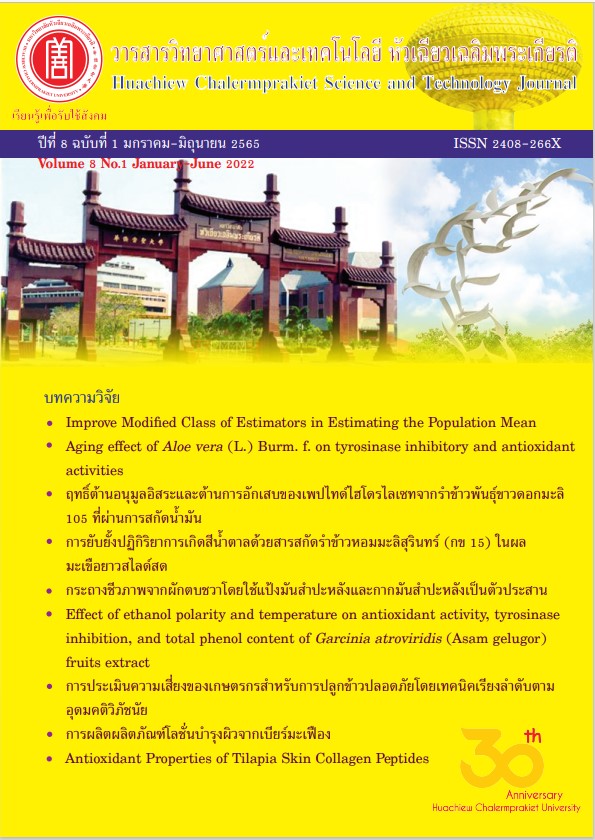การผลิตผลิตภัณฑ์โลชั่นบำรุงผิวจากเบียร์มะเฟือง
คำสำคัญ:
เบียร์มะเฟือง, ปริมาณฟีนอลิกทั้งหมด, โลชั่นบำรุงผิว, สารต้านอนุมูลอิสระบทคัดย่อ
งานวิจัยนี้มีวัตถุประสงค์เพื่อศึกษาการผลิตผลิตภัณฑ์โลชั่นบำรุงผิวจากเบียร์มะเฟือง และวิเคราะห์คุณสมบัติทางกายภาพ ทางเคมี และทางจุลชีววิทยา ทำการศึกษาโลชั่นบำรุงผิวทั้งหมด 3 สูตร ได้แก่ โลชั่นควบคุม โลชั่นเบียร์เอล และโลชั่นเบียร์มะเฟือง ในการประเมินคุณสมบัติทางกายภาพ โดยดูจากลักษณะภายนอกของโลชั่น เช่น ลักษณะเนื้อโลชั่น สี และกลิ่น พบว่าในการวิเคราะห์หาฤทธิ์การต้านอนุมูลอิสระด้วยวิธี 2,2-diphenyl-1-picrylhydrazyl (DPPH) ผลิตภัณฑ์โลชั่นบำรุงผิวเบียร์มะเฟืองมีอัตราการยับยั้งสารอนุมูลอิสระสูงที่สุด คือ 51.80% ตามด้วยโลชั่นเบียร์เอล 37.41% และน้อยที่สุดคือโลชั่นควบคุมที่มีอัตราการยับยั้งสารอนุมูลอิสระเพียง 20.80% และในการวิเคราะห์สารประกอบฟีนอลิกทั้งหมดด้วยวิธี Folin-Ciocalteu พบว่าโลชั่นเบียร์มะเฟืองมีปริมาณสารประกอบฟีนอลิกทั้งหมดสูงที่สุด ตามด้วยโลชั่นเบียร์เอล และโลชั่นควบคุม ซึ่งมีปริมาณสารประกอบฟีนอลิกทั้งหมด 2,158.1 1,921.9 และ 1,194.2 ไมโครกรัมของกรดแกลลิกต่อมิลลิลิตร ตามลำดับ และจากการนำผลิตภัณฑ์โลชั่นบำรุงผิวทั้ง 3 สูตรมาวิเคราะห์ทางจุลชีววิทยา ได้แก่ จำนวนรวมของแบคทีเรีย ยีสต์ และราที่เจริญเติบโตโดยใช้อากาศ และจุลินทรีย์ก่อโรค ได้แก่ Staphylococcus aureus, Pseudomonas aeruginosa, Candida albicans และ Clostridium spp. พบว่าผลิตภัณฑ์โลชั่นบำรุงผิวทั้ง 3 สูตรที่นํามาทดสอบมีจำนวนรวมของแบคทีเรีย ยีสต์ และราที่เจริญเติบโตโดยใช้อากาศ < 10 CFU/g และไม่พบการปนเปื้อนของจุลินทรีย์ก่อโรคทั้ง 4 ชนิด
เอกสารอ้างอิง
Giacosa A, Barale R, Bavaresco L, Faliva MA, Gerbi V, Vecchia C, Negri E, Opizzi A, Perna S, Pezzotti M, Rondanelli M. Mediterranean way of drinking and longevity. Crit Rev Food Sci Nutr 2016;56(4):635-40.
Zapata P, Esplá A, Vilaplana A, Lax D, Artiaga L, Barrachina A. Phenolic, volatile and sensory profiles of beer enriched by macerating quince fruits. LWT Food Sci Technol 2019;103:139-46.
Sierksma A, Kok FJ. Beer and health: from myths to science. Eur J Clin Nutr 2012;66:869-70.
Nardini M, Garaguso I. Characterization of bioactive compounds and antioxidant activity of fruit beers. Food Chem 2020;305:125437.
Michalek IM, John SM, Santos FL. Microbiological contamination of cosmetic products-observations from Europe, 2005–2018. J Eur Acad Dermatol Venereol 2019;33(11):2151-7.
Parvez S, Kang M, Chung SH, Cho C, Hong CM, Shin KM, Bae H. Survey and mechanism of skin depigmenting and lightening agents. Phytother Res 2006;20(11):921-34.
Valim F, Oliveira EA, Kamimura ES, Alves AD, Maldonado RR. Production of star fruit alcoholic fermented beverage. Indian J Microbiol 2016;56(4):476–81.
เสาวนีย์ กระสานติสุข, หทัยชนก รุณรงค์. การพัฒนาตำรับโลชั่นบำรุงผิว. วิทยานิพนธ์ปริญญาเภสัชศาสตรบัณฑิต คณะเภสัชศาสตร์, มหาวิทยาลัยมหิดล. กรุงเทพฯ; 2549.
สุรพงศ์ รัตนะ, บรรลือ สังข์ทอง. ฤทธิ์ต้านอนุมูลอิสระ ปริมาณฟีนอลิก และปริมาณฟลาโวนอยด์ของสารสกัดคัดเค้า (Oxyceros horridus). วารสารหมอยาไทยวิจัย 2563;6(2):1-10.
สุนันทา ข้องสาย, ลักษมี วิทยา. สารประกอบฟีนอลิก สารประกอบฟลาโวนอยด์ และฤทธิ์ต้านอนุมูลอิสระของสารสกัดจากเสม็ดขาวและเสม็ดแดง. ใน: เอกสารประกอบการประชุมวิชาการ The 15th International Conference on Multi-functional Materials and Applications (ICMMA 2021) ครั้งที่ 15 วันที่ 25 พฤศจิกายน 2564. มหาวิทยาลัยเทคโนโลยีราชมงคลศรีวิชัย. ตรัง; 2562. หน้า 16-21.
ตมิสา จันทวงศ์, เตชินี เผ่าผาง, ธีริศรา โพธิ์ทองมา, มงคล เพ็ญสายใจ. การพัฒนาผลิตภัณฑทําความสะอาดเสนผมและหนังศีรษะจากเบียรเชอรรี่. วารสาร มรภ.สข. วิชาการ 2564;2(1):23-32.
BAM. Bacteriological Analytical Manual–Chapter 23: Microbiological Methods for Cosmetics. [Internet].2017 [cited 2022 February 2]. Available from: http://www.fda.gov.com
Pauline M, Alexandre O, Andoseh B, Tetmoun M, Abeline S, Agatha T. Production technique and sensory evaluation of traditional alcoholic beverage based maize and banana. Int J Gastron Food Sci 2017;10:11-5.
Yoshida S, Yokoyama A. Identification and characterization of genes related to the production of organic acid in yeast. J Biosci Bioeng 2012;113:556-61.
Wei SD, Chen H, Yan T, Lin YM, Zhou HC. Identification of antioxidant components and fatty acid profiles of the leaves and fruits from Averrhoa carambola. LWT Food Sci Technol 2014;55:278-85.
Tronina T, Poplonski J, Bartmanska A. Flavonoids as phytoestrogenic components of hops and beer review. Mol 2020;25(18):4201.
Leong LP, Shui G. An investigation of antioxidant capacity of fruits in Singapore markets. Food Chem 2002;76:69-75.
Lim YY, Lim TT, Tee JJ. Antioxidant properties of tropical fruits: a comparable study. Food Chem 2007;103(3):1003-8.
Lovett PN. Shea butter: Properties and processing for use in food. Specialty Oils and Fats in Food and Nutrition. 1st ed. UK : Woodhead Publishing; 2015.
Kubola J, Siriamompun S, Meeso N. Phytochemical, vitamin C and sugar content of Thai wild fruits. Food Chem 2011;126:972-81.
Starkel P, Saeger CD, Delire B, Magat J, Jordan B, Konda VR, Tripp ML, Borbath I. Tetrahydro iso-alpha acids and hexahydro iso-alpha acids from hops inhibit proliferation of human hepatocarcinoma cell lines and reduce diethylnitrosamine induced liver tumor formation in rats. Nutr Cancer 2015;67(5):748-60.
Nowak K, Wrona WR, Gorska M, Jablonska E. Parabens and their effects on the endocrine system. Mol Cell Endocrinol 2018;(474):238-51.
สำนักงานมาตรฐานผลิตภัณฑ์อุตสาหกรรม. มาตรฐานอุตสาหกรรมเอส : ผลิตภัณฑ์บำรุงผิวผสมสมุนไพร. [อินเตอร์เน็ต]. 2562 [เข้าถึงเมื่อ 6 มี.ค. 2565]. เข้าถึงได้จาก: https://www.tisi.go.th/assets/website/pdf/tiss/15-2562.pdf
ดาวน์โหลด
เผยแพร่แล้ว
รูปแบบการอ้างอิง
ฉบับ
ประเภทบทความ
สัญญาอนุญาต
ลิขสิทธิ์ (c) 2022 วารสารวิทยาศาสตร์และเทคโนโลยี หัวเฉียวเฉลิมพระเกียรติ

อนุญาตภายใต้เงื่อนไข Creative Commons Attribution-NonCommercial-NoDerivatives 4.0 International License.
บทความทุกบทความที่ได้รับการตีพิมพ์ถือเป็นลิขสิทธิ์ของ คณะวิทยาศาสตร์และเทคโนโลยี มหาวิทยาลัยหัวเฉียวเฉลิมพระเกียรติ



